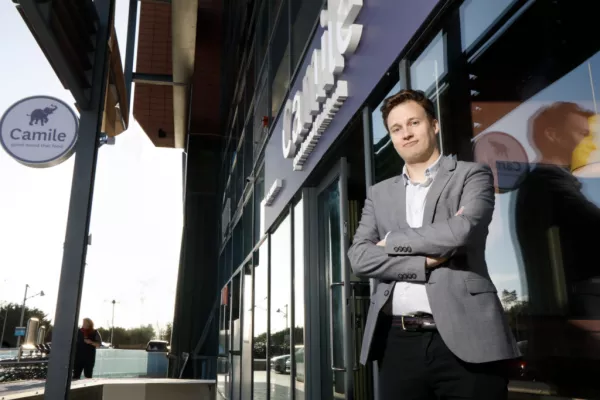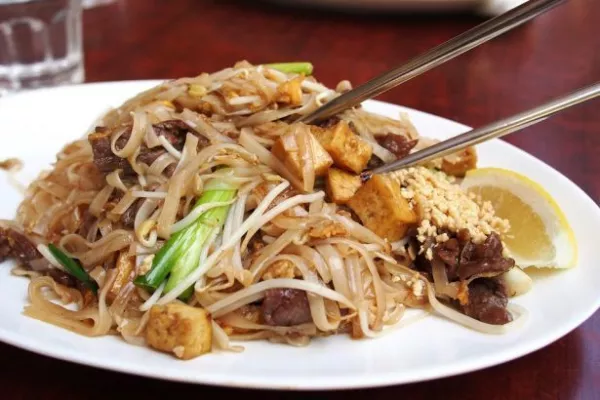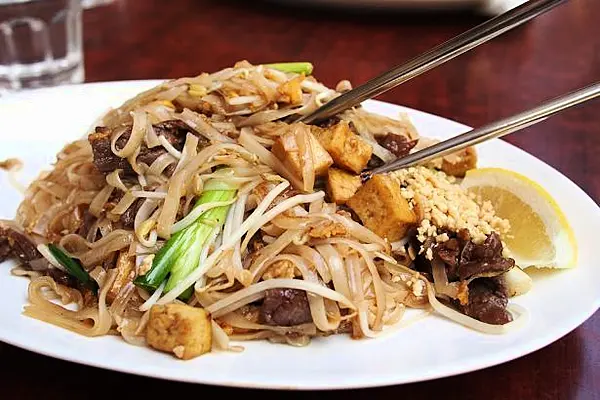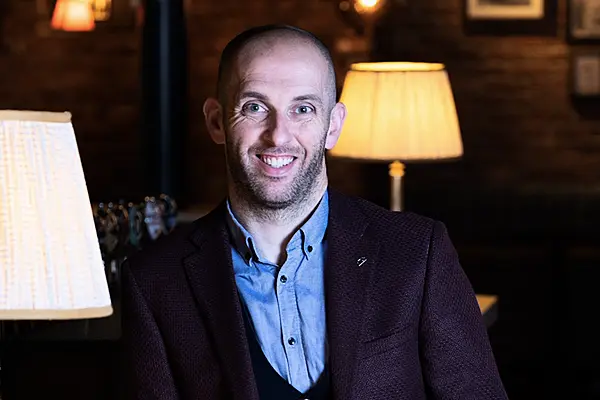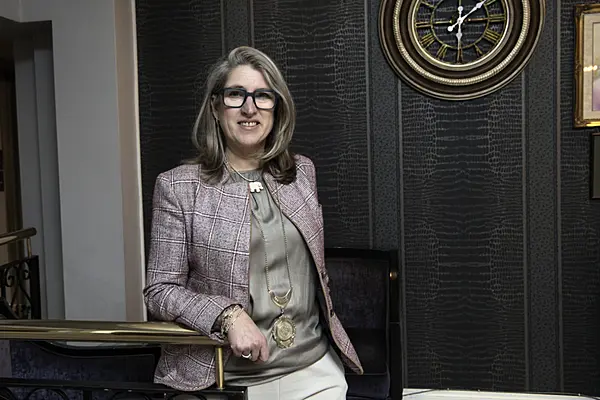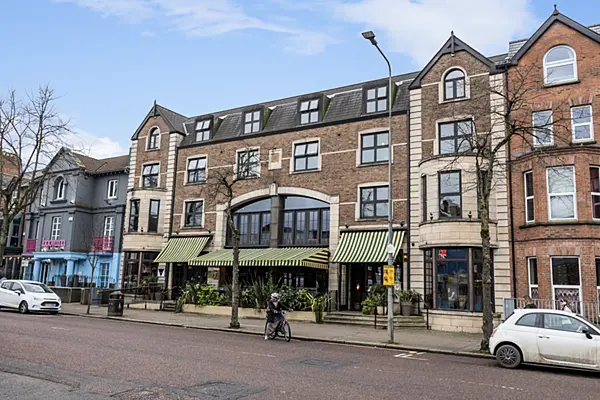‘Pivot’ was undoubtedly the word of the moment during the first lockdown, as restaurants everywhere scrambled to reinvent themselves, moving into meal kits, takeout, delivery, and click-and-collect. Many did this very successfully, but what about those places that already existed in that space? How has the last peculiar year been for them? Hospitality Ireland talks to Brody Sweeney, founder of Camile Thai and a man who knows a lot about tough times and reinvention.
This article was originally published in the Spring 2021 issue of Hospitality Ireland Magazine, in April of 2021.
The first lockdown, we got a fright, like everybody else,” says Brody Sweeney, “and we weren’t at all sure what to do, with a lot of pressure to close down, particularly from staff and from franchisees who were very nervous about coming in – and, in fact, a lot of them didn’t come in at the start – so we had a real problem in March, actually keeping open.”
Once he decided to stay open – partly in the spirit of being an essential service, somewhere to feed people, and partly from “a pure business side of it” – Camile adapted quickly.
“We were primarily focused on offpremise sales already. Before the pandemic, we were about 70 per cent offpremises, and we’re almost exclusively located in residential suburbs, so we don’t really have anything in city centres or shopping centres. So, we were well placed to take advantage of the fact that people were at home in the suburbs, and we had a service that could deliver to your home.”
He was, however – Brody is quick to stress – “very conscious of what was going on in the world around us. One of the things we got involved in at the very start was setting up an organisation called Save Our Restaurants Coalition. We pulled together a lot of people from the industry. We put our heads together and tried to come up with a set of policy recommendations for government. From the very beginning, I was really conscious of the disastrous situation that so many people in hospitality were in. I had been there before – I’ve been bust myself – so I know how debilitating it is when the world is collapsing around you. So, that response was kind of trying to do something for the industry. Generally, we were really conscious that, for 90 per cent of people in hospitality, it was a disaster.”
Initially, business, Brody says, “wasn’t amazing” in the early months. “We were grateful to be open. We kicked along until about June, when the first lockdown lifted, and then, for some reason, the business just took off, and we had really good growth for all the rest of the year and into this year.
“We’ve had to do all the things everybody else has had to do – all the safety protocols. Currently, we don’t allow people onto the premises. We have, obviously, everybody in the masks, cleaning of all our work surfaces and our hands. We have perspex screens separating staff within the branches, where we can. Practically speaking, we are in a business where it’s hard to practise social distancing – you’re in a hot kitchen – but we do our best.
“In some cases, we had to close branches temporarily and sort them out, but not very many. We were so lucky, in the sense that we were primarily located around suburbs. Doing home delivery off our premises is in our DNA, so we’d already worked out the menu and how to deliver it. We already had the packaging, the logistics piece – we had the technology in our restaurants. We had the app, meaning that we had the online ordering experience, so we just kind of ramped that up, and we’ve been really fortunate that it’s worked out well for us. When you look at, maybe, 80 per cent of restaurants being closed at the moment, we’re one of the 20 per cent that’s managed to stay open, and we get more business – because of the fact that the 80 per cent are closed – than we would expect to have in the normal year.”
How many venues are there now in Ireland, and how is the London side of things going?
“We have 35 restaurants in Ireland and six in London. London is going really well, although we had a tough start there. What I mean by that is that, for the first three years there, we lost a lot of money, and this year we’ll lose very little. We’re still not making it, but we’re very close to the tipping point. We have a bunch of new restaurants opening in London this year, on top of the six we have, and then we think we have a good chance of getting another three as well. We have a really big programme in Ireland, too, so we’ve a lot of development in the works because all of that was held back last year. We worked hard on it – it’s taken a good while – but we will get there. There’s a lot happening.”
One of the things happening has been a kind of coalition with existing hospitality outlets, driven by the pandemic.
“We genuinely saw a lot of people being in trouble in the business, so we developed a kind of franchise, where we would go into an existing hotel or restaurant or pub and have them open up a Camile business within their existing facilities. So, we did the first mid-year, last year, in a big bar in Sligo, which had a kitchen they weren’t using. We got them going with a Camile business, and it’s worked out really well, for a relatively little investment.”
Presumably, that has been able to stay open, then, even when the pub had to close…?
“Yes, the shutters have been down on the pub, but they’ve got that off-premises business, which is the only business they have at the moment, and so they’ve been delighted with us. We’ve got a few more of them coming on around the country: in Castlebar, Mallow, possibly Letterkenny – regional towns where there’s an existing good-quality operator, who, just by circumstance, has found themselves closed at the moment. We’re able to come in with a food solution, which is not just about the pandemic. For a lot of bar operators, food is a bit of a pain point. There are some very good gastropubs, but a lot of pubs find it a pain in the arse. This can be a complete kind of solution.”
How quickly can Brody’s team set up such a thing?
“It took eight weeks to get that open in Sligo. They already had investment in their toilets and cold rooms and their front of house, so we’re literally remodelling an existing kitchen, and only in small ways – taking out a cooker, putting in a wok burner – or putting in an ecosystem and a bit of a marketing programme, and off we go. That’s all easy stuff for us because that’s what we do, and that’s been quite interesting. For the wider hospitality industry, I think it’s one of the innovations that have come out in response to this because it definitely wasn’t on our radar this time last year, but it’s good business for us, and it’s potentially good business for the local operator, who, through no fault of their own, has been shut.”
In terms of the tech side, has he added or refined anything that the business had been using?
“We’ve had our app, which is just about 50 per cent of our business, for eight years, and we’ll spend half a million quid on it this year, improving it. In order for it to keep up to speed with your Revolut app or your Deliveroo app, that takes constant investment and refining – and it’s big money.
“We’ve been doing our drone trials – that’s been very cool. We are delivering away in Galway, where we’re trialling it. We’re the first in Europe to deliver food commercially by drones, and we’re doing orders every night.”
How exactly does it work?
“You make the order. We know from your postcode where your house is, so we ‘Google Earth’ the image, and we will have mapped a grid over your house and will have picked a square where we’re going to drop the food – to your front door or your back door, or somewhere in the garden – and then we cook the food, load it into the drone, which takes off to about 400 feet. It flies to your house, hovers over the designated square, sends you a text message, saying, ‘Your food is here. Do you want to receive it?’ If you say yes, then the drone comes down to about 40 feet, and then the little door opens underneath, and the food comes down on the string, which, very importantly, is biodegradable. It lets it gently onto the ground, the string unravels from the drone, and it flies back to base.
“This innovation does three things for us: one, it’s cheaper – we think, when it’s fully operational, it will be about half the price of a delivery driver; two, it’s much quicker for the consumer – there’s no traffic jams, no traffic lights, it just goes straight – so, when our drone takes off, on average, it’s taken three minutes to delivery; and three, it’s environmentally friendly. Instead of sending a car, we’re sending a renewable, electric-powered drone that has almost no carbon footprint. On every level, it’s really cool because we’re primarily in residential suburbs. Most of our deliveries are within two miles, weighing about two kilos. An average order, for us, has two main courses – that’s a perfect payload for a drone. The radius is perfect delivery distance, and in the suburbs, most houses most have a garden. It’s not that you can’t drop without one, but it’s harder because there’s less space.”
How difficult are apartment deliveries, then?
“I think, soon they’re going to be building landing pads outside apartment front doors, so it won’t deliver to your fourth-floor window, but they’ll send you a message, and you come down to the front door and get it – like with a courier. It’s a game-changer for us, as a business, but it’s game-changer for all of us because it will take cars off the road. We will get used to seeing these things buzzing around the sky. They don’t have cameras, so there are no privacy issues, and they’re not that noisy, so they’re not irritating.”
So – rookie question – are they preprogrammed, or does somebody guide them from base?
“No. You just put your GPS with the coordinates for that square, on that grid, by your house, and that’s it. You just go out and pick it up. It’s easy, and because they’re not landing, you’re not going to have the risk of them being vandalised or landing on somebody’s head.”
What other tech innovations is he looking at?
“Another bit of technology we’re working on is semi-automating our cooklines. So, just think about how labour intensive industries like hospitality are, with almost no automation in kitchens. If you think about our business, on a Saturday night, we could have five chefs standing at the oven and cooking away, and the action of flipping a wok is actually quite a repetitive, mechanical action, so we found a system where we can replicate the chef standing with the wok. So, we’ll build a bank of these woks – five or six of them in a line – and we could have one chef feeding it and one chef emptying it, so instead of having five chefs cooking, you have two.”
All this innovating – is this because Brody has been burned before, or is that just his nature?
“Yes, I’ve been burned before,” he laughs, “but we love the innovation bit. We’re doing other things, too – like we may be the first chain in Europe to print carbon footprints for each dish on our menu. That’s really cool, and that’s starting to link how we eat our food and the impact it has on the environment. We’re pretty sure, when we start doing it, our footprint is going to look horrible, but it’s the awareness that gets us started to think how we can help.”
Would he not worry that, if Camile discloses the carbon footprint of what its customers order, that people won’t understand that all outlets are similar, and penalise them for their honesty?
“We were among the first here to put calories on the menu. There was a debate at the time – would it cost us business? – and it didn’t. In fact, for the kind of cohort we’re trying to aim our business at, it works really well. They appreciated it. Now they might completely ignore it, but they at least had the knowledge to make a decision, and if the decision was to ignore it, that’s a decision based on knowledge, rather than guessing. So, it didn’t penalise. I’d say the opposite – it actually helped us.”
The demographic may be even more motivated by the environment?
“You could be completely right about that, so we work, first off, with compostable packaging. People really appreciate that, but it also opens cans of worms for us because now we’re kind of held to account on it – we have to walk the walk. It’s kind of a journey. Compostable packaging is part of it, but we also want to get into reusables, like milk bottles. We did research on this last year, before the pandemic. We ordered reusable cups and bowls, and we asked people, ‘How would you feel about using these in Ireland?’ We asked 200 people, and most said, ‘Those are amazing. You’re so innovative, and you’re so creative. It’s just wonderful, but we wouldn’t use them,’ and they wouldn’t use them because they’re not very convenient. So, we get comments like, ‘Oh, well, I’ve only got a small apartment. What would I do with the empties while I was waiting for you to collect? I’d have to wash them up.’ It comes with the carbon footprint bit that, you know, people are very into saving the planet, but not if it’s inconvenient.”
Brody’s not stopping there.
“We believe that single-use anything is not good, so we will try and minimise that. We will actively work on taking the plastic bottles out of our restaurants this year. We’ll either have glass or cans because we know what plastic is doing. That is just walking the walk, and we do feel, as a business, that our job is to kind of lead the way. Think about compostable coffee cups – five years ago, there were no compostable coffee cups, then companies started using them, and now everybody uses compostable coffee cups. That’s the default position and happened in five years. Now, that has stalled with Covid, and they’re still not disposed of properly – there are still lots of issues – but the point is: a couple of companies took a lead on it and the price came down, and then it became the norm. We think the same will happen with the compostable packaging we’re using. There’s a marketing benefit from being first to do it, too, so we would lead the way, and then others will follow, and then we’re all trying to make the place better, trying to improve the fast-food and delivery/takeaway industries that are horrible for litter. The junk they create – we’re saying, ‘Well, let’s see what we can try to do to make that situation better.’ We’re never going to fix it, but if we got 20 per cent of our customers to use reusables and we’re using compostable, that’s a start.”
He points out, “If putting our carbon footprint out there makes us think about, for example, ‘Maybe we don’t need to import that oil from Thailand – we can use a rapeseed oil from Ireland,’ that’s a benefit. It helps you to start thinking about how you can make a difference, and that’s a really important part of our brand. It’s kind of in our DNA that we’re trying, at least.”
Camile currently employs around 800 people, Brody says, adding, “I think that we’re adding another 300 this year.”
Finally, I ask, did he feel any pain, in business terms, when so many restaurants began to ‘pivot’ and start to do takeaway and delivery?
“Not really. People were desperate to do anything to keep going, so, yes, the supply side grew – lots of restaurants tried – but the demand grew even quicker. It wasn’t an issue.”
As he also points out, “It looks simple – ‘Just put it into a box and deliver it!’ – but, actually, it’s really hard. We’ve spent 11 years trying to perfect this, and we’re not perfect at all, but we do have 11 years of learning about it.”
He cites an example, saying, “One guy I was talking to in Galway – he’d set up to do home delivery. He was a fine-dining restaurant, and he set up to do home delivery using social media. He was delighted the first weekend, that he got 50 orders on the Friday night, but the delivery process wasn’t great, so the next weekend, there were fewer orders, and by the third weekend, he got fewer again, and then he gave up. Other people are much better at the dining-in side than us. We concentrated on the off-premises business.
“There has been amazing innovation, too. I love the Guinness-in-the-back-of-thevan thing, and places like Forest Avenue doing amazing grocery shopping – that was brilliant – and people doing the meal kits. There’s been so much incredible innovation, but a lot of people were just desperate to try something, and often it ended up not really working out for them, and then they get burnt out and wonder, is it worth the hassle?”
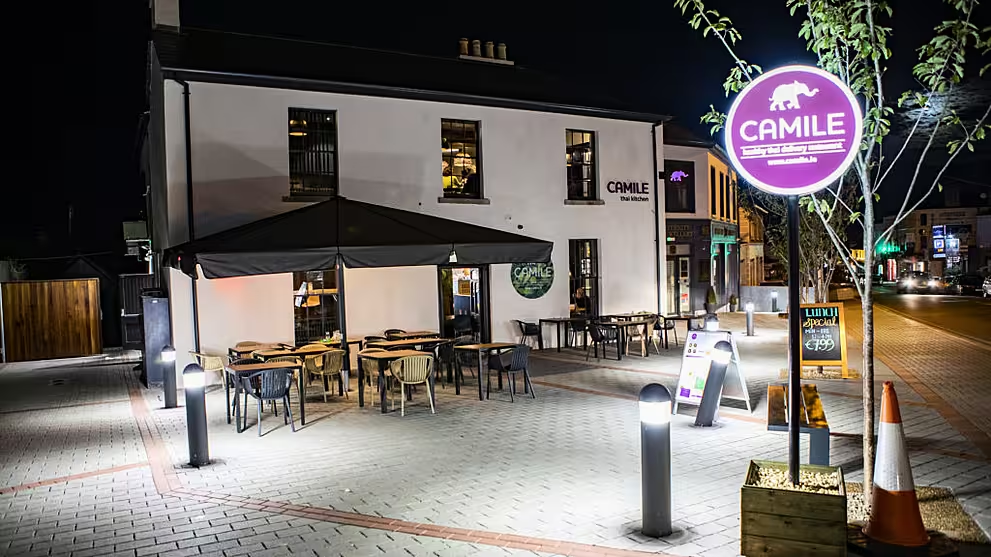
Camile Thai Restaurant exterior
Camile Thai at a Glance
NUMBER OF RESTAURANTS - IN IRELAND AND LONDON: 37 outlets across Ireland and the UK with the latest ones in Canary Wharf REEF and Bangor which just opened at the weekend in the UK
HOW MANY ARE FRANCHISED (BREAKDOWN UK/IRE): 8 are owned and operated by Camile, the other 31 are franchised
NUMBER OF STAFF: 200
OPENINGS PLANNED FOR 2021: 15 new locations across the UK and Ireland: Eight of the 15 new locations will be in Ireland, with new Irish locations including The Point Village in Dublin, the new Frascati Centre in Blackrock, and several other locations in Waterford, Mayo, Dublin, and Cork. Seven out of the 15 new locations across the UK and Ireland, will be in the UK, new locations including the Epsom, Twickenham and Streatham suburbs of London and Surrey.
Read More: Hospitality Ireland Spring 2021: Read The Latest Issue Online!

